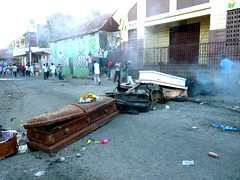
CAP-HAITIEN – The first barricade looked harmless enough. Foot-long rocks piled next to each other in a line.
But as the bus driver slowed down, flying rocks landed in the street – thrown by youths crouching in the bushes up the hill.
“We don’t really have a country! The police don’t do anything!” a nun sitting across from me complained after the bus driver negotiated, with a little cash, our way past.
The man next to her said the country will always be mired in problems until a leader like Hugo Chavez or Fidel Castro takes power.
We must have passed a dozen more barricades, most unmanned.
After Limbe, where cholera has killed at least 100 people, we came to the biggest “barikad” yet in the highway. Thick trees lay across the road and hundreds of people, a few holding machetes, blocked the way.
The bus driver once again descended to negotiate, but didn’t appear to be making any progress. Most passengers grabbed their belongings and got out.
I decided to go too. As I gathered my things, there was a debate among the remaining passengers:
“He’s a blan (foreigner), he’s going to get hurt.”
“No no no, he speaks Creole, he’ll be fine.”
“They’re going to think he’s MINUSTAH. They’re not logical.”
MINUSTAH is the acronym for the UN peacekeeping mission. As I stepped off the bus, people standing on at the road called me over and urged me not to go. It was the third day of so-called “cholera riots” against foreign troops blamed for introducing the disease into the country.
Someone said the protesters are violent “chimere,” a word for political gangs. I explained that it’s my job as a journalist to go talk to them.
Then two Haitian journalists who were on the bus pushed their way through the crowd and wrapped their arms around me. Everyone agreed, finally, that together with the two guys I could get through the barricades.
Elizer and Duval were coming back home to Cap Haitien. They were scared for me, saying under no circumstances should I talk with protesters or take photos. I reluctantly agreed to follow their instructions.
I wondered if perhaps the UN peacekeeping mission was right in saying these were protests were organized by a politician or gang. “Enemies of stability and democracy,” MINUSTAH mission head Edmond Mulet called them. So far, I’d only seen young men in the street.
But as we passed through each barricade, everyone – young girls and rotund market women mingling with demonstrators yelled out, “MINUSTAH ou ye?”
I yelled back, “Non, mwen se yon journalis Amerikan.” The suspicious stares softened into smiles and understanding looks. After passing the third barricade that way, we started laughing.
One teenager who threw a rock at us as we approached on motorcycle said, “pa gen pwoblem” – no problem – after I held out my press badge.
As we arrived on the outskirts of Cap Haitien proper, the streets were deserted except for people gathered around barricades. One was still flaming. At another, dozens of men milled around a burnt out car.
Read the rest at Mediahacker.org →

No comments:
Post a Comment